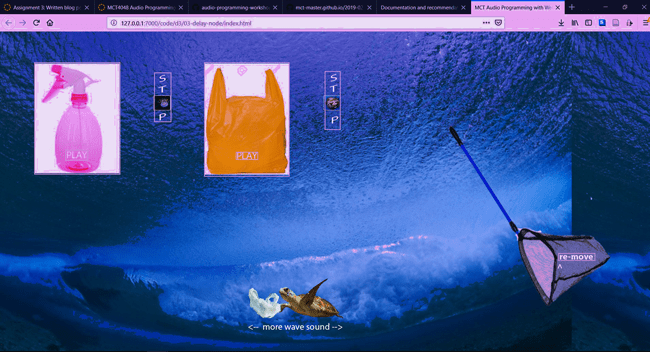Catch the wave – First week's dive into web audio programming
Getting familiar with some of the basic JavaScript syntax was the first day’s work. We did small practices and learned about the interplay of different web technologies like HTML, CSS and JavaScript which shed some light. Apart from the nice things one can do with web audio as we learned through different online examples the main possibilities for me have been opened by skimming some of the papers from the web audio conferences and the mini-presentations of some selected papers introduced by the fellow students. It is possible to create simple, but effective applications on the web browser, even without prior knowledge. However, it took way longer to implement those ideas, but luckily there is always someone around to ask.
Mini-Logbook and achievments
It took some time to decide what I want to go for more in-depth since there are so many options. The first day I tried to work with audio spatialization online. The code I found was pretty advanced and I did not want to spent to much time understanding it, so I rolled back to something more simple as a start. Inspired by the tone.js and its examples on audio sound synthesis with sample files I got the idea to create something similar. Finally I chose to work with audio samples, uploading them and processing them on the web browser like here. I spent a lot of time finding out how to ask for content. Gradually things became more clear. Signal flow chart helped a lot to visualize what is happening.

Different tasks require different workflows, to adapt within a different environment turned out to be useful. It was essential to start with templates and then move on and research more examples online and then copy paste different parts of the code elements. One of the main challenges was to not despair and keep sticking to the matter. The spaghetti code will eventually make sense at some point. Of course in the long run skills like creativity and looking for unconventional paths are of use since there are different ways to get to the same goal. And that works best with trial and error and letting yourself get inspired and motivated by more interesting things than you’re working at the beginning.
Make the argument function
Ever returning questions were, how can I recognize the difference between a function, an argument and other means of code? When will I finally learn when to use what and why. It is recommended expecting to achieve the full spectrum of patience and endurance more than once. And it happens to not see the forest for the trees. I had to overcome that idea of doing something complex which blocked me at the beginning, in spite of the fact that it can get quite complex at some point. What it basically is as I realized equals more building abstract blocks and pieces, elements and trying to keep them together. The good thing is with audio programming that you immediately are able to prove what you have been coding simply by listening – is there any sound? It keeps you in the flow and motivates to explore further.
What’s next?
I hope to create something collaboratively in the group project and have the possibility to develop the project further and dive deeper.
